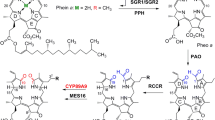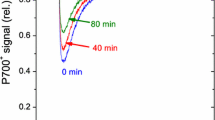Abstract.
During senescence of flowering plants, only breakdown products derived from chlorophyll a were detected although b disappears, too (Matile et al., 1996, Plant Physiol 112: 1403–1409). We investigated the possibility of chlorophyll b reduction during dark-induced senescence of barley (Hordeum vulgare L.) leaves. Plastids isolated from senescing leaves were lysed and incubated with NADPH. We found 71-hydroxy-chlorophyll a, 71-hydroxy-chlorophyllide a, and, after incubation with Zn-pheophorbide b, also Zn-71-hydroxy-pheophorbide a, indicating activity of chlorophyll(ide) b reductase. The highest activity was found at day 2 of senescence when chlorophyll breakdown reached its highest rate. Chlorophyllase reached its highest activity under the same conditions only at days 4–6 of senescence. Based on the chlorophyll b reductase activity of plastids at day 2.5 of senescence (=100%), the bulk of activity (83%) was found in the thylakoids and only traces (5%) in the envelope fraction. Chlorophyll b reduction is considered to be an early and obligatory step of chlorophyll b breakdown.
Similar content being viewed by others
Author information
Authors and Affiliations
Additional information
Received: 22 February 1999 / Accepted: 24 March 1999
Rights and permissions
About this article
Cite this article
Scheumann, V., Schoch, S. & Rüdiger, W. Chlorophyll b reduction during senescence of barley seedlings. Planta 209, 364–370 (1999). https://doi.org/10.1007/s004250050644
Issue Date:
DOI: https://doi.org/10.1007/s004250050644




